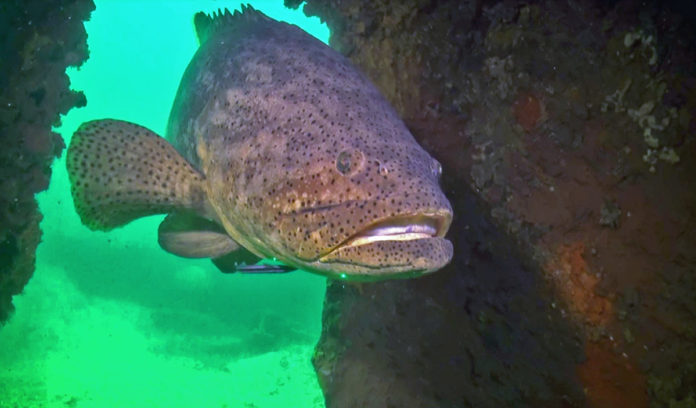
By: Jim McCarthy, Charlotte Twine and Mandy Miles
An abundance of goliath grouper in Florida has prompted state wildlife officials to consider allowing a limited harvest of the giant protected fish in state waters — including sections to the north of the Florida Keys. The Florida Fish and Wildlife Conservation Commission recently approved a proposed draft rule to provide access to goliath in certain areas, but it’s not a done deal.
The draft rule approved earlier this month would allow the recreational harvest of up to 200 goliath grouper per open season from March 1 to May 31. Of those 200, up to 50 could be taken from Everglades National Park.
An angler would need a recreational goliath grouper harvest permit and tag that would be issued via a random-draw lottery. Lottery winners would be allowed one fish per person, per open season. Harvested goliath would need to measure within a slot limit of 20 to 36 inches total length.
Harvest would be permitted in state waters, but nearshore areas from Palm Beach County south through the Atlantic coast of the Keys and within Dry Tortugas National Park are off limits. A map depicting allowable areas for harvest, however, shows bayside waters to the north of the Keys as open.
Harvest of goliath would continue to be prohibited in federal waters, where FWC does not have management authority for the fishery.
Applicants could only receive one permit and tag per open season. If selected in the lottery, anglers would be required to pay a $500 special use permit fee. FWC said the proposed fee offsets the cost of materials and staff time needed to conduct this program. Permits and tags would be non-transferable.
An FWC report on the draft rule proposal states that fishery managers, researchers and fishermen are seeing increased goliath grouper numbers in Florida.
“Goliath is a rebuilding stock that is becoming more abundant in many parts of Florida and is a species that serves an important role in the marine ecosystem,” an FWC report states. “As the abundance of goliath has increased, so has the frequency of interactions and conflicts with fishermen and divers.”
Keys locals with an interest in the fate of the goliath grouper — conservationists, commercial fishermen and charter boat captains — differ widely in their opinions about the FWC’s proposed draft rule and its prohibition in the Florida Keys.
Don DeMaria is a Ramrod Key-based commercial fisherman for marine life tropical fish with a passion for conservation.
“This is FWC Commissioner Robert Spottswood’s pet project. He wants to kill them (goliath grouper),” DeMaria told Keys Weekly. “And he’s ignored all data that the population is in decline. The FWC has cherry-picked data. REEF data shows the population is going down. It’s not wise what the FWC is doing.”
“Conservation is not about closing a resource forever,” said Spottswood in response. “It’s about closing it as a management measure and giving access back when we can.I believe we are at this point, and it is a small and productive step in the right direction.”
Islamorada-based commercial fisherman Jesse Hayes, who catches stone crab and lobster, believes that the population needs to be curbed.

“I’m absolutely in favor of lifting the ban,” Hayes said. “Goliath grouper are a pain for both my target species. They’re worse than cockroaches out there. When there is an overabundance of those fish, it takes a lot of biomass to keep and sustain and grow an animal of their size. Their sheer size requires a lot of food. They are down there vacuuming sea life. I promise you, an average Goliath grouper harvests more seafood than I do.”
Capt. Stan Miles, who has been a charter captain in Key West and Marathon for more than 35 years, said goliath grouper is an example of a conservation success story that has now become too successful.
“We’re seeing 400-pounders in 8 feet of water. Adults and juveniles are on all the wrecks and reef sites, eating lobster and snapper from several different areas. They have no predators and their abundance now is negatively impacting other species,” Miles said.
Conservationist and Islamorada resident Xavier Figueredo is the founder of Florida Bay Forever and a catch-and-release sport angler. “I’m dead set against this opening up. I’d like for the ban to stay in place. … Though 200 fish statewide is not a huge issue. That’s a nice compromise.”
When asked about the plight of commercial fishermen who possibly compete with goliath grouper for stone crab, Figueredo said, “I feel bad for stone crabbers. But I feel maybe the amount of stone crabs taken by groupers is overestimated. … The bigger problem we have is we are overfishing. The population of anglers has exponentially increased.”
Richard Stanczyk is the co-owner of sportfishing marina Bud n Mary’s in Islamorada. Though he would like to see the goliath grouper remain protected, he points out that a lot of sportfishermen don’t like goliath grouper as they’ll “lose a yellowtail or snapper because the goliath grouper will engulf it.”
Attempts to quantify the goliath’s growing numbers through a traditional stock assessment were rejected by independent expert reviewers and the federal fishery management councils’ scientific advisors. FWC’s report states that it’s because of unknowns surrounding the goliath’s life history and uncertainty about maximum age, as well as the absence of long-term data and lack of information about the stock outside the southeastern U.S.
Goliath has never been listed under the U.S. Endangered Species Act. In 2006, NOAA Fisheries removed goliath from their Species of Special Concern list when a status report showed a significant increase in abundance in the U.S. population, with goliath re-establishing themselves in their historical range.
FWC said it has gone through an extensive stakeholder engagement process, with staff conducting 16 public workshops throughout the state. Since 2017, FWC said, 8,000 comments came back regarding goliath management. Feedback varied from allowing limited harvesting to maintaining the status quo of catch-and-release.
With initial approval by FWC, staff will gather public feedback on the draft rule and return for a final public hearing at the March 2022 commission meeting. Staff also recommends returning in three to five years after final approval with an update.























